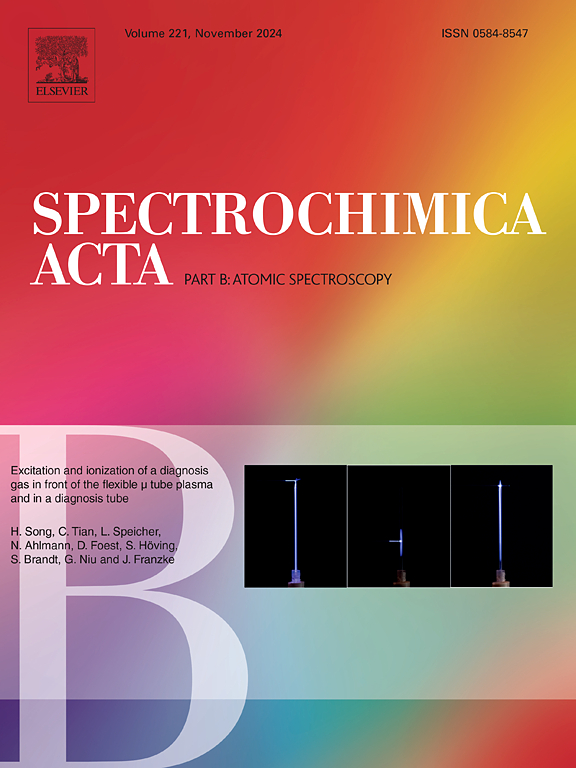用激光诱导击穿光谱实时监测痕量稀有气体——大块气体对等离子体特性和灵敏度影响的研究
IF 3.8
2区 化学
Q1 SPECTROSCOPY
引用次数: 0
摘要
评价了Ar和He本体气体对激光诱导击穿光谱(LIBS)实时监测痕量Xe和Kr的影响。LIBS是一种用于测量熔融盐系统中惰性气体输运的监测工具,传统传感器可能面临辐射、腐蚀性材料和/或混合相的挑战。在静态和各种流动的Ar和He流(0-5 L min - 1)中测量了LIBS等离子体的等离子体温度和电子密度。与使用He气体相比,使用Ar气体导致等离子体温度升高,电子密度增加一个数量级,并延长了等离子体寿命。气体流速对等离子体温度影响不大;然而,它对电子密度的影响是显著的,这表明需要考虑流速特定的模型。基体效应对两种散装气体的发射峰均有影响。由于这些矩阵效应,我们开发了两种气体中Xe和Kr在0到700ppm范围内的多元模型。虽然预测行为相似(预测均方根误差在11.1 ~ 20.6 ppm之间),但He的检出限更优(Xe: 22.9 ppm, Kr: 30.4 ppm)。这些模型用于示范性实时测试(1小时),无论散装气体如何,都显示出很强的预测精度(相对标准偏差5%)。最终,本研究为开发用于实时监测的气态LIBS模型时所需考虑的因素提供了指南。本文章由计算机程序翻译,如有差异,请以英文原文为准。

Real-time monitoring of trace noble gases using laser-induced breakdown spectroscopy—An investigation of the impact of bulk gas on plasma properties and sensitivity
The impact of Ar and He bulk gases on laser-induced breakdown spectroscopy (LIBS) real-time monitoring of trace Xe and Kr was assessed. LIBS is being developed as a monitoring tool for measuring noble gas transport in molten salt systems, in which traditional sensors may face challenges associated with radiation, corrosive materials, and/or mixed phases. The plasma temperature and electron densities of LIBS plasmas were measured in both static and various flowing Ar and He streams (0–5 L min−1). The use of an Ar bulk gas resulted in higher plasma temperature, greater electron densities by an order of magnitude, and extended plasma lifetime compared with when He bulk gas was used. Gas flow rate was found to have little impact on plasma temperature; however, its effect on electron density was significant, indicating the need to consider flow rate–specific models. Matrix effects on emission peaks were reported for both bulk gases. Due to these matrix effects, multivariate models were developed for Xe and Kr ranging from 0 to 700 ppm in both bulk gases. Although the predictive behavior was similar (root mean square error of prediction ranging from 11.1 to 20.6 ppm), the limits of detection were superior in He (Xe: 22.9 ppm, Kr: 30.4 ppm). These models were employed in demonstrative real-time tests (>1 h), which showed strong predictive precision (relative standard deviation <5 %) regardless of the bulk gas. Ultimately, this study provides a guide for the considerations required when developing gaseous LIBS models for real-time monitoring.
求助全文
通过发布文献求助,成功后即可免费获取论文全文。
去求助
来源期刊
CiteScore
6.10
自引率
12.10%
发文量
173
审稿时长
81 days
期刊介绍:
Spectrochimica Acta Part B: Atomic Spectroscopy, is intended for the rapid publication of both original work and reviews in the following fields:
Atomic Emission (AES), Atomic Absorption (AAS) and Atomic Fluorescence (AFS) spectroscopy;
Mass Spectrometry (MS) for inorganic analysis covering Spark Source (SS-MS), Inductively Coupled Plasma (ICP-MS), Glow Discharge (GD-MS), and Secondary Ion Mass Spectrometry (SIMS).
Laser induced atomic spectroscopy for inorganic analysis, including non-linear optical laser spectroscopy, covering Laser Enhanced Ionization (LEI), Laser Induced Fluorescence (LIF), Resonance Ionization Spectroscopy (RIS) and Resonance Ionization Mass Spectrometry (RIMS); Laser Induced Breakdown Spectroscopy (LIBS); Cavity Ringdown Spectroscopy (CRDS), Laser Ablation Inductively Coupled Plasma Atomic Emission Spectroscopy (LA-ICP-AES) and Laser Ablation Inductively Coupled Plasma Mass Spectrometry (LA-ICP-MS).
X-ray spectrometry, X-ray Optics and Microanalysis, including X-ray fluorescence spectrometry (XRF) and related techniques, in particular Total-reflection X-ray Fluorescence Spectrometry (TXRF), and Synchrotron Radiation-excited Total reflection XRF (SR-TXRF).
Manuscripts dealing with (i) fundamentals, (ii) methodology development, (iii)instrumentation, and (iv) applications, can be submitted for publication.

 求助内容:
求助内容: 应助结果提醒方式:
应助结果提醒方式:


